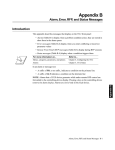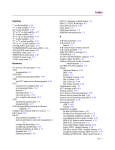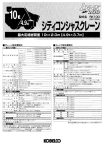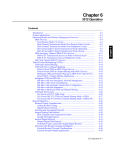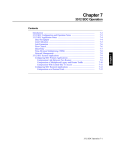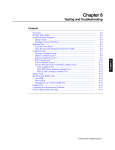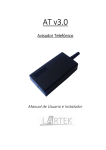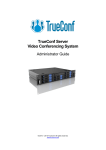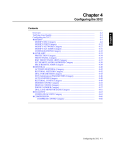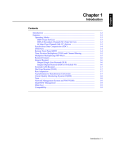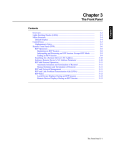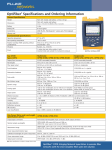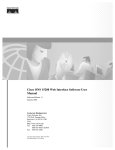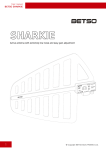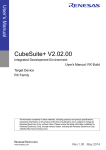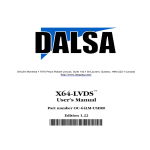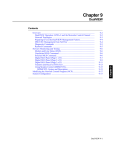Download Tran:3512 DSU/CSU User`s Manual:Ch5:3512 Status
Transcript
Chapter 5 3512 Status Overview ....................................................................................................... STATUS .................................................................................................... 3512 e f r c (Default Display) Category ................................................... Default Display Examples ................................................................... LINE SELECT Category ......................................................................... e ALARM STATUS Category ................................................................... e CQMS Category (where e specifies the line) ........................................ e LINE STATISTICS Category (where e specifies the line) .................... PORT STATUS Category ......................................................................... COMPRESS STATUS Category .............................................................. RESTORAL STATUS Category .............................................................. NETWORK MESSAGE Category ........................................................... Ser # nnnnnnnnn........................................................................................ SWREV n.n c ........................................................................................... SDC SWREV # n.n .................................................................................. STATUS and Remote Front Panel (RFP) .................................................. * * 5-2 5-2 5-4 5-4 5-5 5-5 5-8 5-9 5-10 5-11 5-12 5-13 5-13 5-13 5-13 5-13 3512 Status 5-1 Chapter 5 Contents Overview During normal operations, you use parameters under the STATUS main menu to monitor conditions within the 3512 or 3512 SDC unit and on the line. * *STATUS STATUS parameters let you monitor EIA signal and transmission service conditions. Figure 5-1 shows the 3512’s STATUS main menu. * 5-2 3512 Status * *STATUS *STATUS 3512 efr (See Table 5-1) e =Current line f =Current line service type r =Current line rate LINE SELECT e ALRM STATUS (See Table 5-1) Line =Primary :Alternate Clear Alarms =Yes :No No SDN Alarms SDN Addr Queue GEN ALARM xx:xx:xx:xx:xx e CQMS (See Table 5-1) Signal Level Jitter e LINE STATS (See Table 5-1) Line Avail Error Free PORT STATUS EIA Signals=Pn (n=Port 1-4) xx:xx:xx:xx:xx Err Prob BPV Pn i @ r Pn RTS CTS Pn DCD DSR Pn DTR n = port i = electrical interface r = port rate COMPRESS STATUS Tx TP=xxxxxx bps RESTORAL STATUS State =Inactive :InProgress :Active :Holding NETWORK MESSAGE No Message Ser #nnnnnnnnn SW rev #n.n c Sig Qual =Good :Poor Rx TP=xxxxxx bps TX Level=y dBm (y=0 to -12) Tx Lnk Util=xxx% Init= (See Table B-4) Rx Lnk Util=xxx% Term= (SeeTable B-4) Fail= (See Table B-4) Shaded parameters display only on 3512 SDCs. Some categories and parameters display only when optional features are installed. c =Current configured options SDC SW rev #n.n c Figure 5-1. *STATUS Categories and Parameters (SDC Parameters Shaded) 3512 Status 5-3 3512 e f r c (Default Display) Category ✳ STATUS 3512 e f r This category, where e, f, r and c represent the elements shown in Table 5-1, is the default display, Table 5-1. 3512 Default Display Information This symbol... Represents this display element... 3512 Product Name e Currently-active line f Currently configured service type r Current line rate And can take these values: 3512 3512 SDC Prim (primary line) Alt (alternate line) RFP (Remote Front Panel) When e = Prim: DDS1 DDS2 64CC REST When e = Alt: DDS1 SW 56 0 - 64.0 Default Display Examples Some default displays are: This display... 3512 Prim DDS1 9.6 3512 Alt SW 56 Specifies... A 3512 with DDS-I type primary-line service at 9.6 kbps A 3512 with Switched 56 type service (which is always 56 kbps) NOTE: • When Method=Integral ( RESTORAL main menu, RESTORAL METHOD category), the effective rate displays * • When Method=A/B, the Rest Rate option ( RESTORAL main menu, RESTORAL CONFIG category) displays * Some default-display elements can be changed from the FRONT PANEL category ( AUXILIARY main menu). For details, refer to Chapter 4. * 5-4 3512 Status LINE SELECT Category ✳ STATUS LINE SELECT This category’s single parameter lets you choose the communication line, primary or alternate, whose current information you want to display in the e ALARM STATUS, e CQMS, and e LINE STATISTICS categories. Primary: Select this option to specify that the subsequent displays apply to the primary communication line. PRIM, or PR, displays for e when you select this option. Alternate: Select this option to specify that the subsequent displays apply to the alternate communication line (which is usually used for restoral applications). ALT displays for e when you select this option. e ALARM STATUS Category ✳ STATUS e ALARM STATUS parameters (where e is Prim or Alt) display messages that describe problems with the local unit, network connection, and compression link. For a list of alarms and error messages that can display on 3512 SDCs, refer to Appendix B. e ALARM STATUS SDC Clear Alarms Default: Off Options: On, Off Description: This parameter clears primary-line and alternate-line alarms, regardless of the current Line Select option, from the alarm queue. Yes: Clears alarms. No: Does not clear alarms. To... Do this: Scroll through alarms Press Clear all alarms, on both lines Use the Clear Alarms parameter For more information, refer to Appendix B. GEN ALARM QUEUE Up to ten abbreviated alarm messages, which include alarm start and stop times, are stored in the Gen Alarm and Slave Alarm queues, in reverse chronological order. The exact message abbreviation depends on the features in the unit.The following alarms display in the appropriate queue: Abnormal Station Code (AS) AS displays when service-provider equipment reports network problems. 3512 Status 5-5 Automatic Stream Disconnect (ASD) ASD displays when the ASD feature disconnects a port. Compression Link Fail (CLF) This alarm displays when there is a problem with the compressed-data line. Dial Line Monitor (DLMF) This alarm displays when there is a problem with the integral-restoral line. Latching Loopback (64LL) LB displays when the unit detects a latching loop signal on a 64k CC line. Link Down (LD) LD displays when: • LD=On and CQMS Signal Level=0 • The unit has the SW 56 feature but no restoral line is connected. In this situation, the alarm is constantly generated but it does not affect 3512 operation. You can stop the alarm by setting Method=A/B (RESTORAL METHOD category). Local Loopback (LL) LL displays when a local loopback (sealing current reversal) is detected on the receive line. Master Down (MDN) MASTER DOWN displays at a slave when the master does not respond to the slave's CRY FOR HELP after a specified period of time. This alarm is cleared when the master responds. This alarm is not sent to the NMS. No Sealing Current (NSC) NSC displays when the local loop sealing current has been interrupted. Out of Frame (OOF1, OOF2, OFCC) These alarms indicate out of frame codes on the receive line or that the 3512 cannot detect framing on a DDS or 64k CC line. 5-6 3512 Status Out of Service (OS) OS indicates Out-of-Service codes on the receive line. Out of Sync (OSY) OSY displays when the 3512 has not received synchronization characters used for bitstealing or muxed operation. OSY occurs in MP-Mux mode: • At the master device, when the master detects synchronization loss and is unable to determine which slaves are out of synchronization. The master initiates a full retrain. OSY displays until the slaves are retrained. • At a slave device, when a slave cannot synchronize on frames from the master. OSY displays until the slave detects the SYNC character. Remote Terminal (RT) RT displays when RT=Enable and the service provider initiates a remote terminal loopback. Slave Down (SDN) SDN displays at a slave device when it cannot be synchronized. The slave sends Idles until the next attempt. SDN is cleared when the slave is successfully synchronized. SDN displays at the master device when a slave fail to train due to: • An incorrect address at the master or slave • A loss of power at a slave An SDN alarm is cleared when the slave is synchronized by a retrain. Unknown Slave (UNK) At the master device, UNK displays when there is a slave whose address is not in the master’s poll list. This alarm clears when the addresses of all slaves on the multipoint circuit have been added to the master's list, and a retrain has succeeded. The alarm clears regardless of the status of the slave down alarm. At the slave device, UNK displays when the master does not attempt to train the slave due to incorrect addressing. The slave sends Idles until the next retrain. This alarm clears when the master trains the slave. 3512 Status 5-7 e CQMS Category (where e specifies the line) ✳ STATUS e CQMS Circuit Quality Monitoring System (CQMS) parameters provide information about the received digital signal on line e (refer to Table 5-1 for the values of e). Table 5-2 lists CQMS parameters. NOTES: 1) CQMS accuracy varies with the configuration and operating environments. Use it in conjunction with established test procedures and equipment to pinpoint and resolve network problems. 2) When a restoral session is initiated or terminated, CQMS parameters are reset and recalculated. Table 5-2. CQMS Parameters and Operating Modes in Which They Can Occur Parameter Signal Level Jitter Bipolar Violations Error Probability DDS-I, Main Channel mode √ √ √ √ DDS-I, Muxed, BitSteal modes √ √ √ √ DDS-II SC, All modes √ √ √ SW 56 √ √ √ √ 64k CC √ √ √ Signal Level Signal Level is the relative peak amplitude of the received signal, with a range from 0 to 10. (No units are assigned to these values because the power levels of the receive signal vary with the data pattern and the data rate.) 10 indicates the strongest signal; 0 indicates a very small signal level, or none at all (Link Down alarm). The service determines the local loop signal strength (for example, 9.6 kbps is generally transmitted at half the power of other rates). Because the received level is generally proportional to the wire length to the signal source, a small Signal Level value is not necessarily a cause for concern. However, a sudden change in level, or a disparity between a poor line and a good line at a common location, can help you troubleshoot line problems. Jitter (%) Jitter on the digital line is derived from the receive phase lock loop. To calculate Jitter, the 3512 measures received pulse widths over time, calculates an average, and then measures the difference between individual widths and the average. While not a true measure of jitter, the value does strongly correlate with it. Jitter may be affected by line length and noise. 5-8 3512 Status Bipolar Violations (BPV) BPV is the number of DDS-I code violations (invalid control codes) that have occurred in the last 15 minutes. Fifteen or more is considered high. Err Prob (Error Probability%) This parameter analyzes a data stream. Error Prob, which can confirm line deterioration, increases as distortion increases. When operating with end-to-end framed data (BitSteal or Muxed), a running Cyclic Redundancy Check (CRC) is used to detect end-to-end data errors. In these modes, this parameter is extremely accurate. However, in other modes, the error probability is a function of the other CQMS parameters. It incorporates DDS-II SC framing errors, if applicable. In these cases, this parameter is only an estimate. e LINE STATISTICS Category (where e specifies the line) ✳ STATUS e LINE STATISTICS parameters monitor line impairments (refer to Table 5-1 for the values of e). Table 5-3 shows the line statistics available with Opmode options. Table 5-3. Operating Modes in Which Line Statistics are Calculated e LINE STATISTICS Parameter DDS-I DDS-I (Muxed and DDS-II SC DDS-II SC (Main (Muxed) (Normal) SW 56 64k CC Channel) BitSteal) Line Availability% √ Error Free Seconds% *In muxed and bitstealing modes √ √ √ √ √ √ √* √ √* Line Avail (Line Availability%) Description: Line Availability indicates the time that the unit has been in service over the last 15 minutes. The value decreases if: • A Link Down condition is detected • The signal level is inadequate • Out of Service, Out of Frame, or Abnormal Station alarms are received Error Free (%) Error Free estimates the error-free time in the last 15 minutes of operation. This parameter displays only when DTE Config=BitSteal or Muxed. 3512 Status 5-9 PORT STATUS Category ✳ STATUS e PORT STATUS PORT STATUS parameters monitor EIA signals (RTS, CTS, DCD, DSR, and DTR) on the active line, and display a DTE port's electrical interface and rate. n indicates a port, up to the number present in the unit, selected in the EIA Signals parameter. EIA Signals=Pn Default: P1 Options: P1, P2, P3, P4 (depending on the number of ports in the unit) Description: This parameter specifies the port that the following parameters apply to. Select a port as follows: 1) From *STATUS, press 2) Press to display: until PORT STATUS displays. EIA Signals=Pn (n=1-4) 3) Press to scroll through the available ports. 4) Press to select a port. Pn i @r Options: For i: EIA232, V.35 Where: • n is the port, selected in EIA Signals=Pn parameter • r is the data rate Description: This parameter displays port n’s electrical interface configuration, which is selected in the Pn Intfce parameter ( MODIFY, MODIFY PORT). * NOTES: 1) For integral restoral, the port rate may differ from the configured rate, if the restoral modem uses rate negotiation. 2) The port rate is determined by the P-to-Ch and CHn options: • CHn (MODIFY DSU) sets the primary line channel rate • CHn (RESTORAL CONFIG) sets the alternate line channel rate 5-10 3512 Status EIA Signal Status The remaining PORT STATUS parameters display the state of a port’s RTS and DTR input signals and CTS, DCD, and DSR output signals: • RTS/CTS • DCD/DSR • DTR A box displays to the right of each signal. If the box is solid, the signal is asserted. If the box is empty, the signal is de-asserted. COMPRESS STATUS Category ✳ STATUS The COMPRESS STATUS category, which displays only on devices with the synchronous data compression (SDC) feature, lets you check the current condition of the active 3512 SDC line. The unit calculates these statistics only when operating in compression mode. e COMPRESS STATUS TxTP=n bps (Transmit Throughput) Options: For n, 0 - 256000 SDC Description: Tx Tp provides an average, updated once per second, of the data transmit rate through Port 3. This parameter counts only data in HDLC frames. RxTP= n bps (Receive Throughput) Default: (None) Options: For n, 0 - 256000 Description: Rx Tp provides an average, updated once per second, of the data receive rate through Port 3. This parameter counts only data in HDLC frames. Tx Link Util = n% (Transmit Link Utilization Percent) Default: (None) Options: For n, 0 - 100 Description: This parameter provides a running average indicating the percent of assigned line bandwidth transmitting compressed data. Values less than 100 indicate bandwidth is available. 3512 Status 5-11 Rx Link Util = n% (Receive Link Utilization Percent) Default: (None) Options: For n, 0 - 100 Description: This parameter provides a running average indicating the percent of assigned line bandwidth receiving compressed data. Values less than 100 indicate bandwidth is available. RESTORAL STATUS Category RESTORAL STATUS parameters, which display only with the SLR, SW 56, or TDM feature, indicate: ✳ STATUS e RESTORAL STATUS SLR • The current state of the restoral session • The current signal quality and transmit level (for integral analog restoral) • The cause of the initiation, termination, or failure of a restoral session State Options: Inactive, In Progress, Active, Holding Description: State indicates the current restoral condition. Inactive: The unit is operating on the primary line InProgress: A restoral session has been initiated Active: A restoral session has been established Holding: The unit is operating on the primary line; however, the alternate line is being held according to the Holdialine option. NOTE: Holding displays only when Method=Integral. Sig Qual (Signal Quality) Options: Good, Poor Description: Sig Qual evaluates the quality of the restoral-line received signal. NOTE: Sig Qual displays only when the unit has SLR, Method=Integral and a restoral session is active. Tx Level (Transmit Level) Options: -12 to 0 Description: This parameter indicates the restoral-line transmit level, -12 to 0 dBm. NOTE: TX Level displays only when the unit has SLR, Method=Integral and a restoral session is in progress or active. 5-12 3512 Status Init, Term, Fail Messages These parameters indicate the reasons for initiation, termination, or failure of a restoral session. From the RESTORAL STATUS category, press to display Init, Term, and Fail. Table B-4 lists the messages available. NETWORK MESSAGE Category ✳ STATUS This parameter displays messages from the central site. Press to see if a message has been received since power-up. Only one message can be stored at a time. Refer to Appendix B for message descriptions. e NETWORK MESSAGE Ser # nnnnnnnnn This is the 3512's serial number. SWREV n.n c This is the 3512’s software revision display. ✳ STATUS Element n.n c e SWREV SDC only Option [Digits] A D M m N S Meaning Software revision number 3512 has LPDA, network management and MP-Mux features 3512 has LPDA and network management features 3512 has MP-Mux and network management features 3512 has MP-Mux feature 3512 has none of these features 3512 has network management feature SDC SWREV # n.n Description: This is the 3512 SDC software revision display; interpret it as above. *STATUS and Remote Front Panel (RFP) During an RFP session, alarm conditions may occur on either the local or remote device. Alarms are stored in the alarm queue of the device in which they occur, and can be viewed with RFP. 3512 Status 5-13 5-14 3512 Status














